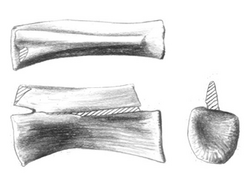Walgettosuchus facts for kids
Quick facts for kids Walgettosuchus |
|
|---|---|
 |
|
| Holotype caudal vertebra seen from three different angles | |
| Scientific classification | |
| Kingdom: | |
| Phylum: | |
| Class: | |
| Superorder: | |
| Order: | |
| Suborder: | |
| (unranked): | |
| (unranked): | |
| Genus: |
†Walgettosuchus
von Huene, 1932
|
| Binomial name | |
| †Walgettosuchus woodwardi von Huene, 1932
|
|
| Synonyms | |
|
|
Walgettosuchus was a type of meat-eating dinosaur that lived in Australia a very long time ago, during the Late Cretaceous period. Its name means "Walgett crocodile," named after the place where its fossil was found. Scientists aren't completely sure about Walgettosuchus because they've only found one fossil: a single tail bone. This makes it a "dubious" genus, meaning its existence as a separate dinosaur is questioned. It might have been related to a group of dinosaurs called Ornithomimosauria, which looked a bit like ostriches.
Contents
Discovering Walgettosuchus
Finding the First Fossil
In 1905, a special fossil was found in Australia. It was an opalized bone from a meat-eating dinosaur. The bone was discovered by Tullie Cornthwaite Wollaston. He found it in a sandy area near Lightning Ridge, close to the town of Walgett in New South Wales.
This fossil was a tail bone, also called a caudal vertebra. It was sent to the British Museum of Natural History in London. In 1909, a scientist named Arthur Smith Woodward reported on the discovery. He then briefly described the bone in 1910.
How Walgettosuchus Got Its Name
In 1932, another scientist, Friedrich von Huene, officially named this dinosaur Walgettosuchus woodwardi. The first part of the name, Walgettosuchus, comes from the town of Walgett where the fossil was found. The word "Suchus" comes from the Greek name for Sobek, an ancient Egyptian crocodile god.
In the 1930s, von Huene often used "~suchus" instead of "~saurus" for dinosaur names. He thought dinosaurs were more closely related to crocodiles than to lizards. The second part of the name, woodwardi, honors Arthur Smith Woodward, who first described the fossil.
The Only Known Bone
The only fossil ever found of Walgettosuchus is called the holotype, known as BMNH R3717. This bone is an incomplete tail vertebra, about 63 millimeters (2.5 inches) long. It was found in rocks from the Griman Creek Formation, which dates back to the Cenomanian age of the Late Cretaceous period.
Scientists noted that this tail bone had concave surfaces on both ends. Von Huene also thought it had long parts that connected it to other vertebrae. He wondered if this dinosaur might be the same as other small meat-eating dinosaurs found in Lightning Ridge, like Rapator.
Where Walgettosuchus Fits In
Dinosaur Family Tree
When Friedrich von Huene first named Walgettosuchus in 1932, he thought it belonged to the Ornithomimidae family. These were dinosaurs that looked a bit like modern ostriches.
However, in 1990, another scientist named Ralph Molnar reviewed the fossil. He found that the tail bone of Walgettosuchus looked very similar to tail bones from other dinosaur groups, like Ornithomimids or Allosaurids. Because of this, it was hard to say exactly what kind of meat-eating dinosaur Walgettosuchus was.
Molnar decided that Walgettosuchus was an "indeterminate theropod." This means it was definitely a meat-eating dinosaur, but scientists couldn't place it in a specific family. He also called it a nomen dubium, which is a scientific term meaning "doubtful name." This suggests that the fossil is too incomplete to be sure it represents a unique dinosaur.
Is it the Same as Rapator?
Some people have wondered if Walgettosuchus and another dinosaur called Rapator are actually the same animal. Both were found in the same area of Australia.
However, it's very difficult to prove this. Rapator is only known from a single hand bone. Since Walgettosuchus is only known from a tail bone, scientists can't compare the two fossils directly. They need to find more bones from both dinosaurs to see if they match up. Until then, they remain separate, though uncertain, dinosaur names.
See also
 In Spanish: Walgettosuchus woodwardi para niños
In Spanish: Walgettosuchus woodwardi para niños

